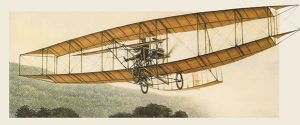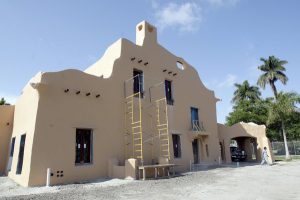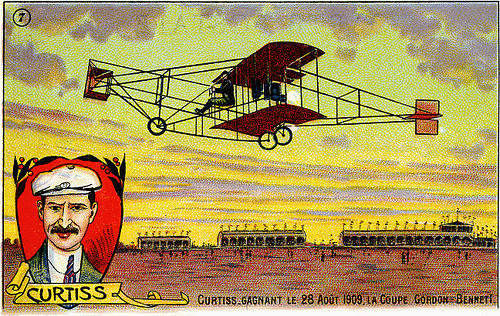Who Is The Man Known As “The Forgotten Lone Eagle?” – May 7, 2021

London City is first major airport controlled by remote digital tower – April 30, 2021
May 6, 2021
The Caterpillar Club – May 14, 2021
May 14, 2021RN3DB
July 16, 2021
Good Evening,
Welcome back to the 3DB……. I hope the week was good for you and you are going to have some time this weekend to catch up with the business of life. Today we are going to talk about Mr. Glenn Curtiss, often referred to as “The Forgotten Lone Eagle,” whose contribution to aviation is equal to that of the Wright Brothers.
The following article is from the Glenn Curtiss Museum and I also have a video that recaps the events found in the article. By the way, did you know that Glenn Curtiss was the first man in the US to be issued a pilot’s certificate?
Enjoy……….
Glenn Hammond Curtiss
Of all the famous aviation pioneers who have been honored for their dedication to the dream of manned flight and their genius for making that dream come true, few can match the creativity and determination of Glenn Hammond Curtiss.
Born in Hammondsport, NY, in 1878, his insatiable curiosity, mechanical ability and ambition soon became evident. By the time he reached his teens, bicycles and speed had become a near-obsession with the young Curtiss. He was a champion bicycle racer for years and naturally progressed to designing and building his own machines. By 1902, Curtiss, with three employees, was manufacturing his own motorcycles under the trade name, “Hercules”. In a measured-mile run at Ormond Beach, Florida, on Jan. 23, 1907, Curtiss’s V8 powered motorcycle was officially clocked at 136.3 mph. On that day, and for years afterward, Glenn Curtiss carried the title, “Fastest Man on Earth”.
Curtiss’s first experience with aviation came when famed balloonist, Thomas Scott Baldwin, ordered a V-twin motorcycle engine to power a lighter-than-air ship. Curtiss’s engine was a success. In 1904, using this early engine, Baldwin’s “California Arrow” became the first successful American dirigible. In 1907, Glenn Curtiss began his aviation career in earnest as a member of the Aerial Experiment Association, a group of men focused on getting a man into the air. In addition to Curtiss, this group included famous inventor, Alexander Graham Bell, F.W. “Casey” Baldwin, J.A.D. McCurdy and U.S. Army Lieutenant Thomas Selfridge.
By this time, the Wright Brothers had already made the first successful controlled flight of a manned aircraft. The Wright Brothers, however, had not allowed public viewing of the flight, and their tendency toward secrecy and continued distrust of the press had resulted in little public notice of the event. It was a mistake that would cost them dearly. On March 12, 1908, the A.E.A. “Red Wing” made the first public flight in America of a heavier-than-air machine with Casey Baldwin at the controls. The craft took off from the frozen surface of Keuka Lake and remained aloft for 20 seconds, covering a distance of 318 feet, 11 inches, before it went down on one wing and crashed. Two months later, the “White Wing” with Curtiss flying it, covered a distance of 1,017 feet in controlled flight. This success was made possible by the addition of “horizontal rudders” (Bell’s term) to the wingtips, a precursor of the aileron.
 (The June Bug was designed by Glenn Curtiss and powered by a Curtiss engine.)
(The June Bug was designed by Glenn Curtiss and powered by a Curtiss engine.)
Using knowledge gained from the Red Wing and the White Wing, Curtiss built the “June Bug”, outfitted with additional improvements. This airplane responded so well in testing, that Curtiss determined to enter it in competition for the Scientific American trophy. Winning the first leg in the 1908 competition involved flying in a straight line for a distance of one kilometer. On July 4, Curtiss piloted the “June Bug” across Pleasant Valley for a distance of 5,090 feet – 1,810 feet farther than required. No less important, it was the first officially-recognized, pre-announced and publicly-observed flight in America. It won Curtiss the first leg of the trophy and established him as America’s foremost aviation pioneer. In 1909, he flew his “Golden Flyer” a distance of 24.7 miles to establish a new world distance record and win the second leg of the Scientific American trophy. Later that same year, in Rheims, France, competing against Europe’s top aviators, he won the Gordon Bennet Cup speed race, averaging 46 mph. In 1910, when the New York World Newspaper offered a $10,000 prize for the first successful flight between Albany and NYC, following the Hudson River, Curtiss again determined to be first, and did so in a craft he had named the “Hudson Flyer”. He won the prize money, nationwide recognition, and in the process, won the third leg of the Scientific American Competition and permanent possession of the coveted trophy. It was his much-publicized Albany to New York flight that established the airplane as having some practical value. It was even suggested that it might have a wartime use. Some months later, Curtiss gave the first demonstration of aerial bombing to Army and Navy representatives at Keuka Lake. In addition to making the airplane a practical reality, he pioneered in the design of seaplanes and flying boats. His interest in water-flying led to an association with the U.S. Navy that was to form a basis for Naval aviation as we know it today. Naval seaplane, flying boat, and aircraft carrier operations are all a direct result of Curtiss’s influence. A final high point in Curtiss’s aviation career came in 1919, when the U.S. Navy Curtiss NC-4 Flying Boat became the first aircraft to successfully cross the Atlantic Ocean.
Curtiss’s interests were not restricted just to vehicles of transportation. In 1921, he essentially left the aviation business and moved to Florida to become a highly-successful land developer. With friends, he developed the Florida cities of Hialeah, Miami Springs, and Opa-Locka. Opa-Locka was intended to be his crowning achievement, a planned community resembling something from the Arabian Nights. In the spring of 1930, he was awarded an honorary Doctor of Science degree from the University of Miami for his many contributions to the development of the Miami area.
 (This was the private home of aviation pioneer Glenn Curtiss, developer of Hialeah, Opa Locka and Miami Springs. The historic site burned down a few years ago. Now the city and private foundation are almost done rebuilding the exterior to the way it was – CHARLES TRAINOR JR, MCT, MIAMI HERALD)
(This was the private home of aviation pioneer Glenn Curtiss, developer of Hialeah, Opa Locka and Miami Springs. The historic site burned down a few years ago. Now the city and private foundation are almost done rebuilding the exterior to the way it was – CHARLES TRAINOR JR, MCT, MIAMI HERALD)
Curtiss’s amazing career was tragically cut short on July 23, 1930. At age 52, while undergoing surgery for appendicitis in Buffalo, NY, he developed a blood clot that ended his life. Glenn Hammond Curtiss was returned to his home town where he rests today in a quiet spot in the Pleasant Valley Cemetery, not far from the site of his historic flight in the “June Bug”.
Curtiss is remembered today as the Father of Naval Aviation and the founder of the American Aircraft Industry.
Have a good weekend, enjoy some quiet time with a good book, and keep friends and family close.
Robert Novell
July 16, 2021



